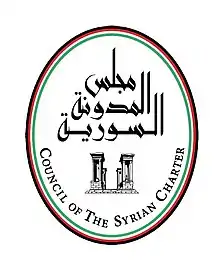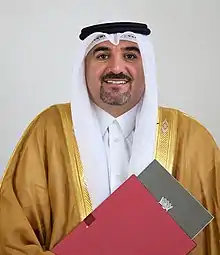The Council of the Syrian Charter
The Council of the Syrian Charter (مجلس المدونة السورية; Majlis al-mudawana al-suriyya) is a Syrian civil society body which officially announced its establishment in spring 2019 to bring together representatives from different families, regions, clans, tribes and religious communities from throughout Syria and from across the Syrian diaspora.[1]


The Council sees itself as "strictly non-partisan" network and as an "interface" between diverse elements of Syrian society, political actors, and the international community.[2]
The name of the Council is derived from a charter called 'Code of Conduct for Syrian Co-Existence' (مدونة سلوك لعيش سوري مشترك), which was signed by its founding members in November 2017.[3] The Arabic word mudawana can stand homonymously for 'charter' or 'code' . The existence of the ‘Code of Conduct’ was revealed to the international media in January 2018.[4][5]
The initiative claims to be the first of its kind as it brought together prominent Syrian societal leaders, across political divides to agree on basic principles for a new social contract in the country.[6] The members of the Council consider themselves influential figures in Syrian society, who are able to facilitate mediation between parties involved in the conflict[7] They comprise representatives of Sunni Arabs, Kurds, Alawites, Druze, Ismailis, Circassians, Yazidis, Turkmens and Christians of various denominations.[1]
The tetrapylon displayed on the Council’s crest evokes the structure of the UNESCO World Heritage Site of Palmyra, which was partially destroyed by ISIL militants in 2015.[8] The tetrapylon symbolises the resilience and cultural diversity of the Syrian people, while the crest’s colours and arrangement may allude to the flag of Syria, the first Syrian Republic or those of the 1930s’ independence movement from the French Mandate.
History and Positions
Among the Council’s founders are members of prominent Syrian families.[1] These include: Mustafa Kayali, a political activist and dentist from Aleppo and the grandson of Abd al-Rahman al-Kayali, who was one of the key figures in the National Bloc of Syria’s independence movement; Sami Khiyami, Syria’s former ambassador to the United Kingdom; Mohammad Habash, a former member of the People's Council of Syria and religious reformist thinker, Ibrahim Ibrahim Basha, sheikh of the Milan Kurdish tribal federation and grandson of tribal leader Ibrahim Pasha Milli, Prince Mulham al-Shibli of the Fawa'ira tribal federation; Sheikh Amir al-Dandal of the Uqaydat tribe of Al-Bukamal (Abu Kamal); Sheikh Oweinan Jarbah of the Shammar, Sheikh Abdelilah al-Melhem of the Annazah tribe; and several other tribal leaders[9][10][11]
The current spokespeople for the Council are Abdallah Rophael, a Syrian Christian lawyer from Homs; Sheikh Amir al-Dandal and Sheikh Mamduh al-Tahhan. Sima Abd Rabo, a former political activist and digital expert from Damascus, served as a spokesperson until January 2020 with Ibrahim Shaheen, a lawyer from the Alawite community of Homs.[12] According to an interview he granted to the public German TV channel ZDF,[13] the Syrian-born German legal scholar Naseef Naeem from the Christian village of Fairouzeh, chaired the negotiations that led to the signing of the Code of Conduct and the creation of the Council.[14]

The eponymous charter, the Code of Conduct for Syrian Coexistence, includes 11 paragraphs on topics such as: the recognition of society’s diversity, the individual (not collective) accountability for crimes and violations during the Syrian Civil War; and the principle of ‘no victor, no vanquished'[15]
In irregular intervals and based on the principles of the Code of Conduct for Syrian Coexistence the Council publishes declarations, mostly on social, societal and ethical aspects of the crisis in Syria. In view of the imminent outbreak of the COVID-19 pandemic in Syria in April 2020 the Council called on all conflict parties to release detainees "in an act of humanity" since detention facilities would not be able to deliver sufficient medical support. The Council also called on the international community to cooperate with the conflict parties and to deliver medical supplies to mitigate against the pandemic on Syrian territory.[16][17]
Controversy
The revelation of the negotiations surrounding the Code of Conduct for Syrian Coexistence, which were conducted in secret,[18][19] drew considerable attention from the international and Arabic press. The case was widely discussed among Syrians inside the country and in the diaspora[20] Citing security concerns, several members of the Council has not officially disclosed their names, a fact that several Arabic commentators have criticized. Despite this, various reports have stated that representatives from the Alawite communities in Tartus, Latakia, Damascus and Homs play key roles in the initiative,[21] which is consistent with some of the Council’s statements.[22]
References
- McGuinness, Damien (2020-01-16). "Syrians hold secret peace summit in Berlin". BBC News. Retrieved 2020-03-19.
- "Council of the Syrian Charter". سوريا ١١ (in Arabic). Retrieved 2020-04-09.
- "مدونة سلوك لعيش سوري مشترك". souria11.org. Retrieved 18 November 2019.
- Hamidi, Ibrahim. "Syria: Sunni-Alawite Talks Yield 11-Article Document in Berlin". aawsat.com. Asharq Al-Awsat. Retrieved 18 November 2019.
- Böhmer, Daniel-Dylan. "Das neue Syrien wird in Berlin gebaut". welt.de. Die Welt. Retrieved 18 November 2019.
- "Antagonisms in the EU's neighbourhood: Overcoming strategic deficits with regard to Syria – How the EU can demonstrate resolve and respond to the interests of regional powers" (PDF). bertelsmann-stiftung.de. Bertelsmann Stiftung. Retrieved 18 November 2019.
- Hamidi, Ibrahim. "Exclusive - Syrian Sunni-alawite Dialogue Forms Council to Implement Coexistence Agreement". aawsat.com. Asharq Al-Awsat. Retrieved 18 November 2019.
- Barnard, Anne (2015-10-05). "ISIS Destroys Historic Arches in Palmyra, Syria". The New York Times. ISSN 0362-4331. Retrieved 2020-03-19.
- Novák, Ondřej. "What's Next? Rebuilding Society in Syria". egic.info. The Euro-Gulf Information Centre. Retrieved 18 November 2019.
- Rudolf, Inna. "Syria's Best of Enemies Breaking Good". icsr.info. ICSR. Retrieved 18 November 2019.
- Deutsche Welle, Arabic. "دور المجتمع المدني في حل الأزمة السورية | DW | 15.01.2020". DW.COM (in Arabic). Retrieved 2020-04-09.
- "Declaration of the Council on the recent election of its' spokespeople, for immediate release". سوريا ١١ (in Arabic). Retrieved 2020-03-19.
- "Geheime Syrien-Verhandlungen: "Unsere Arbeit ist ein Befreiungsakt"". www.zdf.de (in German). Retrieved 2020-03-19.
- حميدي, إبراهيم. ""الشرق الأوسط" تنشر أسرار الحوار السني - العلوي السوري في برلين". aawsat.com. الشرق الأوسط. Retrieved 18 November 2019.
- حميدي, إبراهيم. "وثيقة من 11 بنداً خلاصة حوار سري سني ـ علوي في برلين". aawsat.com. الشرق الأوسط. Retrieved 18 November 2019.
- Hamidi, Ibrahim. "ضغوطات على دمشق لإطلاق معتقلين". الشرق الأوسط (in Arabic). Retrieved 2020-04-09.
- Bundestagsfraktion, Bündnis 90/Die Grünen. "Syrien: Politische Häftlinge müssen umgehend freigelassen werden". Bundestagsfraktion Bündnis 90/Die Grünen (in German). Retrieved 2020-04-09.
- Sallon, Hélène. "Syrie : des représentants alaouites et sunnites signent un " code de conduite pour la coexistence "". lemonde.fr. Le Monde. Retrieved 18 November 2019.
- Metzger, Nils. "Frieden für Syrien - Geheimmission Versöhnung". zdf.de. ZDF. Retrieved 18 November 2019.
- "Confidential Sunni-Alawite Meeting in Berlin Summarized in Eleven-Item Document". syrianobserver.com. The Syrian Observer. Retrieved 18 November 2019.
- Di Feo, Gianluca. "UNA CARTA PER LA PACE IN SIRIA". ricerca.repubblica.it. La Repubblica. Retrieved 18 November 2019.
- رستم, مصطفى. "البيان الأول لعلمانيين سوريين يفتح النار على التطرف الديني والأحزاب السياسية". independentarabia.com. Independent Arabic. Retrieved 18 November 2019.